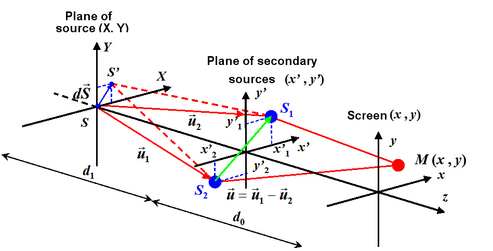
Interferogram with an extended source
In the case of two waves originating from the same extended source, a wave vector corresponds to each point in the source. Thus, each point in the source will contribute to form the interferogram. Therefore, we can see in the observation zone the superposition of all the interferograms that are produced by the all the points in the source.
Qualitatively, if all the interferograms are slightly dephased, one by one, the interference signal will be noisy, which will mean a drop in fringe modulation. This drop in modulation is of the same kind as that of temporal coherence: the amplitude of the cosine is weighed by the degree of spatial coherence of the source.
All points in the source are characterized by their luminance. Each surface element of the source, dXdY, centered on S, produces, after the interferometer, a light distribution of the type [2]:
The virtual “synchronous” sources that were created from a single source by the interferometer are referred to as “secondary sources.” In figure 13 the two secondary sources are represented by S1 and S2. The secondary sources S1 and S2 have their respective coordinates
 and
and
 . The width of the source is materialized by the vector
. The width of the source is materialized by the vector
 .
.

* Figure 13: The shift of the source point of
 produces a variation in the optical path difference.
produces a variation in the optical path difference.